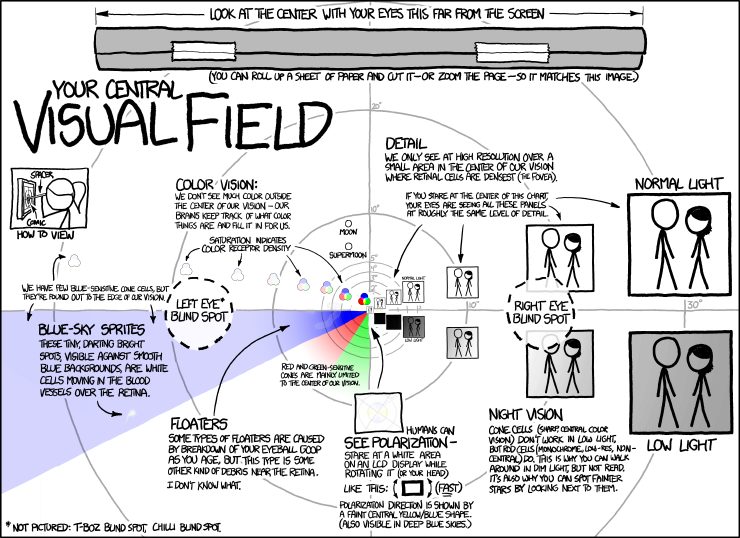This comic shows a number of vision related facts, arranged in a way that they all fit inside your field of vision (the conic area in which you can see at any given time). You're supposed to look at the center of the image while standing about a foot away from the screen (although obviously you can't read the text on the image while staring at the center).
Firstly, there's detail. The eye always sees objects closer to the center with more detail, which Randall illustrates with progressively smaller images, which are seen with the same level of detail (remember that you're supposed to be looking at the center of the image). This is because the retina is denser near the fovea, in the center.
Next, there's the topic of night vision. The color-seeing cone cells don't work so well in the dark, whereas the black-and-white-seeing rod cells do. The rod cells can see shapes well, whereas the cone cells see detail (such as change in color), which Randall uses to explain why we can't read at night.
Polarization direction can be visible when quickly changing your viewing angle. Polarization is essentially the vertical direction of waves. Light, being a wave, has a direction, and is thus polarized. Polarized lenses, for example, would have "slits" to allow only light that is polarized in a certain direction to come through (blocking the light in other directions). LCD screens operate on the principle of blocking and rotating polarized light.
Floaters are deposits within the eye's vitreous humor. While normally transparent, they can occasionally cause refraction of light, making them visible, particularly on bright, blue surfaces. Randall points out that while some floaters are caused by breakdown over time, the others have a more mysterious origin.
Blue sky sprites, properly known as the blue field entoptic phenomenon, are bright sprites seen over bright blue surfaces, particularly the sky. They are white blood cells moving in front of the retina.
Randall also points out that colors are mostly seen near the center of our vision, with our brain keeping track of the colors of things near the outside of our visual field. The cones of blue, red and green in the third quadrant also show how red and green's sensitivity is mostly limited to the center of our vision, whereas we can see blue in a larger field of vision. Our ability to perceive saturation (the intensity of colors) is also stronger near the center of our vision.
The left and right blind spot are the locations of the optic disc, where there are no sensitive rod or cone cells, making a literal "blind" spot. The mention of the "T-Boz blind spot" and "Chilli blind spot" are a reference to the R&B band TLC, whose members go by the aliases "Left eye", "T-Boz", and "Chilli".
An image of the moon and a supermoon also appear in the image. A supermoon is when the moon is at its closest approach to Earth and coincides with a full moon or new moon, causing it to appear larger than normal. At the sizes Randall has drawn the two moons, the difference in size (approximately ten percent) is nigh-imperceptible to the naked eye; Randall seems to be making a comment about how supermoons aren't impressive to him. That he feels like this was already indicated in panel 25 of 1052: Every Major's Terrible and then later confirmed when he published 1394: Superm*n. Here is a list of all comics referring to the term.
The "stopped clock illusion" referenced by the image text is an example of chronostasis, which is an illusion where viewing movement after changing your vision is perceived as taking a longer period of time. So when we look at a clock (which we weren't previously looking at), our field of vision has rapidly changed. The second hand on the clock thus seems to take a longer period of time to move.
